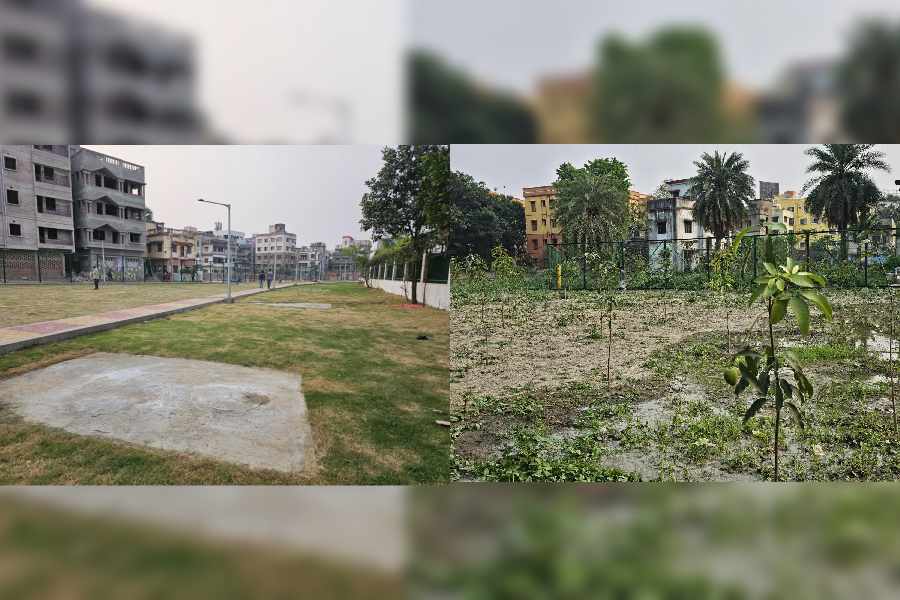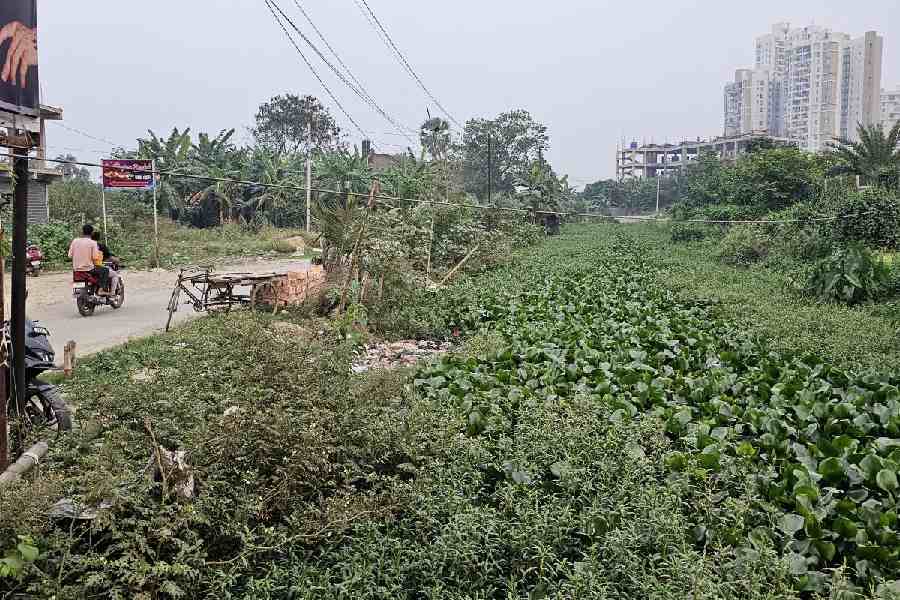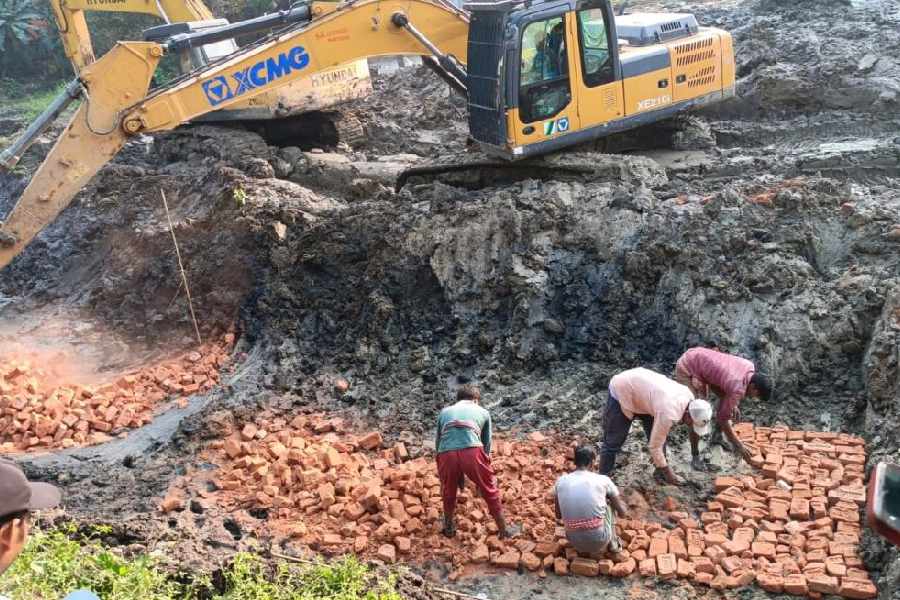Residents of New Town, especially those staying near the canals, dread the approach of sunset. As the shadows lengthen and dusk sets in, columns of the winged pests appear and make it impossible to sit still in the open, be it on benches in parks or inside cars parked at streetsides.
But there is hope of respite within a few monsoons if a vector-control project undertaken by the Newtown Kolkata Development Authority (NKDA) yields the desired result by denying mosquitoes access to dirty water to lay eggs.
“The canals are breeding grounds of mosquitoes. New Town is at a take-off point in terms of population explosion. Unless this is dealt with, we might become an unsmart city in terms of public health. We plan to cover the drainage channels keeping the drainage flow unimpeded,” said Alapan Bandyopadhyay, the new chairman of NKDA.

April 5, 2024: Playground and (right) a mango orchard over a periphery canal in AC Block, New Town.
The NKDA is also holding preliminary discussions with the forest department to grow plantations over stretches of the covers.
“We want to plant mosquito-repelling tall trees like camphor. This will keep mosquitoes away as also increase New Town’s green cover. An inter-departmental engineers’ commitee is finalising the technical aspects,” he added.
New Town is surrounded by man-made canals. These number about 20, ranging in width from 4m to 18m and running a total length of 66km. These, points out former Hidco and NKDA chief Debashis Sen, are peripheral drainage channels which were dug when New Town was created to carry stormwater drained from the township to Bagjola or Kestopur canals.
“They also protect the adjoining villages from being swamped as the township, levelled with clay brought in from elsewhere, is on a higher ground than them. The channels serve as the boundaries between New Town and the adjoining panchayat areas, except in a few stretches where the canal could not be dug due to land dispute and other diversions had to be created,” he said.
But in recent years, the canals were becoming solid waste dumping zones and the flow of water was getting impeded with people from adjoining areas throwing litter, ranging from plastic bottles and packets to kitchen leftovers.
Clean flowing water, explained a senior NKDA official, is not so much of a challenge with regard to vector-borne diseases.
“But the moment you have coconut shells, plastic glasses or similar objects that can act as beds for larvae being tossed in the channel, mosquito born in the water accumulated there are quite certain to be carriers of dengue, malaria and such vector-borne diseases,” he said.
Dengue hotspot
Last year, during a dengue outbreak, NKDA had undertaken a hotspot identification survey. “We found Ward 27 of Bidhannagar Municipal Corporation, which shares a boundary with AC Block of New Town, to be the most affected. The area, behind the Coal India complex and near the Tarulia water treatment plant, had cowsheds for over three decades,” the official said.
An open peripheral canal ran right next to the cowsheds. This is the area that was chosen by NKDA to do a pilot project for the canal cover-up.

The original state of the periphery canal on one side of the road in Action Area III, New Town ahead of Shukhobrishti.
“When we started work in November, there were about 2,000 oxen in the sheds. The whole area, including the canal, was a pool of slurry, resulting from years of accumulation of dung. A man could actually sink if he stepped in the muck,” recalls Rajkumar Dixit of Modern Nursery, whose team has transformed the area in accordance with the blueprint drawn up by NKDA, funded by New Town Kolkata Green Smart City Corporation and executed by Hidco.
The Telegraph Salt Lake took a tour of the transformed area which is now a playground with a raised pathway and playthings like swings and monkey bars spread across 8,500sq m. “We had to drain out water, dredge out the slurry, excavate the ground to a depth of 1200m, fill in and level the land with fresh clay and silversand. Then the ground was soled with bricks and stone dust, sealed with a layer of concrete over which side walls were built. Inside was laid a Hume pipe of 1,400mm diameter — single line in some places and double line where the flow is more and the canal wider. The concrete slabs you are walking by are the openings of manhole chambers created along the canal path at a distance of every 15-20m,” Dixit said, adding that work was finished in February.
The mango orchard, on the outer periphery of which a cowshed still stands on a private plot, has 250 saplings fast growing on the fertile plot into trees of himsagar, dasheri and lyangra varieties across 8,500 sq m. On Sunday, coconut trees were planted along the Coal India complex back wall.
Across the road, the canal continues underneath. Much of its length has already been covered and one has to walk to the end of the plot to watch the open end of the canal before it is covered up.
“From the inlet to the outlet, the length of the periphery channel is about 500m here. The stretch has 22 outfall radial drains joining the channel. We have about 50m left to cover,” Dixit said. The width of the last stretch is so uneven and narrow that pipes cannot be laid here. “We are simply covering up the length with concrete slabs.”

Sections of a periphery canal in AC Block, New Town being covered.
The channels, Sen points out, used to act as a security cover, deterring intruders from moving between New Town and the Tarulia refugee rehabilitation area. “To ensure the covered canal does not allow miscreants to make an easy getaway, there will be 3m high wire fencing,” he said. It is along the poles to put up this mesh that camphor trees are supposed to be planted interspersed with flowering trees.
Canal as road
A second canal which is being covered is ahead of Shukhobrishti housing complex in Action Area III. This is the lane that turns left from a culvert and leads to the NKDA community market, opposite the temporary market that has been set up. Currently it is a single lane running parallel to the canal.
“Once all the stalls open, the approach to the market will become congested. So we have planned a box canal to accommodate the flow of water. Once the canal is completely covered, it will become another lane, widening the approach,” said the NKDA official.

Concrete slabs being laid over the periphery canal on the other side of the main road in Action Area III. This will become a lane of the ring road being planned around Shukhobrishti complex.
There are further plans of setting up an auto and toto stand and a charging station further up. “If we can maintain the canal continuity by connecting the stretch to another stretch across a 1km gap, a road that takes half an hour now to cross will take 10 minutes. This will create a ring road around the Shapoorji complex,” he pointed out.
A proposal to replicate the pilot project across the townhip, divided into three parts, has been submitted to the urban development department for sanction, NKDA sources say.
Write to saltlake@abp.in
